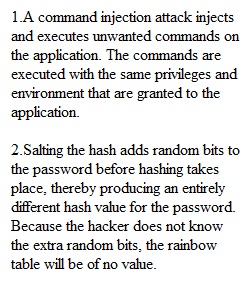


Q Please complete the following Critical Thinking Case Projects that align with this week’s TestOut.com Network Pro learning modules. Record your answers in a Word Document and submit it. 1. How does a command injection attack a web application? 2. How does salting the hash protect your network? 3. What is the target of ARP spoofing? 4. What is the role of a CA in a PKI? 5. Which authentication protocol would you choose if you needed to use smart cards? 6. Which protocol is the secure alternative to Telnet? 7. What is the difference between SFTP and FTPS? 8. Which protocol is added to HTTP for secure Web browsing? 9. With a site-to-site VPN, which devices are configured as the VPN tunnel endpoints? 10. What does PPTP use for encryption? What does L2TP use? 11. What tools can help you find backdoors? 12. What do you need in order to configure two-factor authentication? 13. How does an IPS differ from an IDS? 14. How can packet sniffing and port scanning software be used to improve the security of your network? PreviousNext Week 5 Critical Thinking Project
View Related Questions